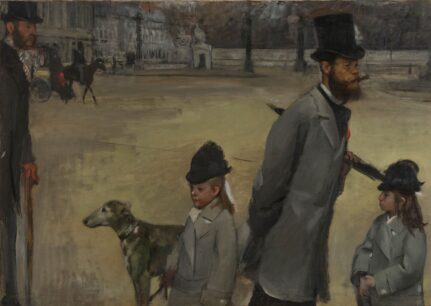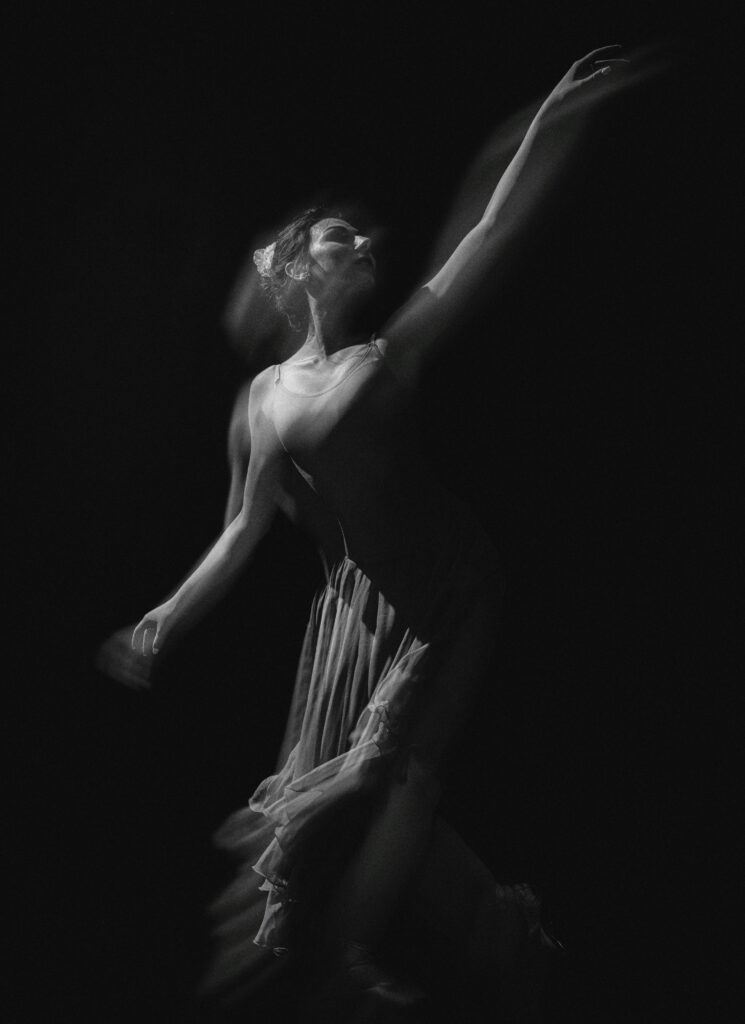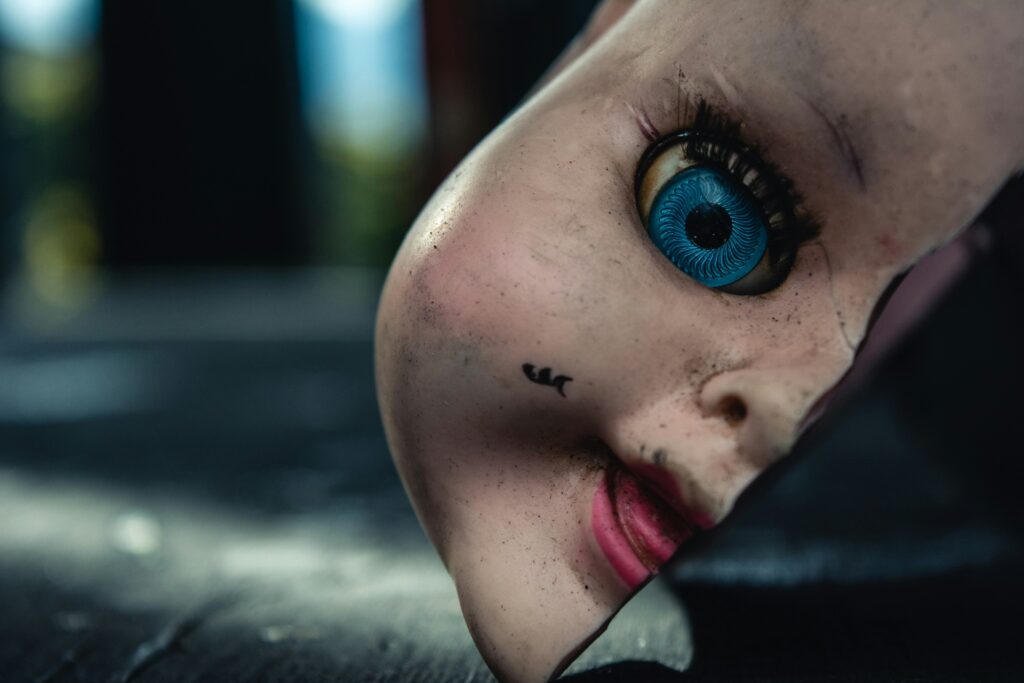The Art of War
Annette Higgs, October 31, 2023
The tour group, art lovers all, trotted behind our Russian guide, whom I’ll call ‘Sergei.’ We were following him through gallery after enormous gallery in the Hermitage Museum in St Petersburg, heads swiveling. Sergei hurried on, no time to dawdle—the Hermitage has three million items in its collection. As we reached the Impressionists, Sergei piloted us past a few mid-ranked Monets and a couple of Pissaros and paused in front of a medium-sized yellow canvas. Several quiet art-lover-type gasps escaped from surprised lips.
‘I thought that had been lost in the war,’ said one person. ‘When I did art history,’ said another, ‘the textbooks said it had been burnt.’
We gazed. The empty yellow field of the Place de la Concorde forms the center of the painting, but the figures surrounding it produce a sense of dynamic movement in all directions. This is Edgar Degas at his compositional best. At the right strides the partial figure of Vicomte Lepic, Degas’s friend and fellow artist, in a tall black top hat. The Vicomte has a bushy beard, a cigar, and an umbrella under his arm. Next to him are his two small daughters outfitted in prim matching overcoats and black caps, and an elegant borzoi. On the left of the painting, a half-figure of an elongated gentleman wears a tricolour cravat. Flashes of color came from the Vicomte’s red buttonhole and the borzoi’s shiny collar.
The diagonal line of the Vicomte’s umbrella under his arm, the little girls with enigmatic expressions looking in different directions, the way the figures are all cut off by the edges of the canvas, the empty space in the center—the picture captures a photographic-like Parisian moment.
Degas painted this scene in 1875, only four years after the end of the Franco-Prussian War. The Strasbourg Monument in Place de la Concorde—barely seen in the background of the painting—became a symbol for Parisians mourning the lost territory of Alsace-Lorraine. Parisians draped it in black on state occasions. What was to be made of Degas’s choice to obscure the monument with the Vicomte’s black top hat? Art historian André Dombrowski called it a ‘highly staged political choice’ for an 1875 audience.
The full title of the painting is Place De La Concorde: Vicomte Lepic and His Daughters. It was a well-known piece of art for many decades but after it was presumed lost in 1945, it could be admired only in reproductions. Then in 1995, the Hermitage unveiled a new exhibition called Hidden Treasures consisting of 74 paintings from a collection which had been in ‘secret storage’ for fifty years, presumably somewhere in the bowels of the museum. Masterpieces by Degas, Van Gogh, Cezanne, Picasso, and Toulouse-Lautrec were brought out into the light. Because they had been kept out of sunlight for fifty years, possibly in complete darkness, the first viewers to see them remarked on how fresh they looked.
Almost all of this fabulous European art had belonged to German private collections before World War II but was seized at the end of the war by the so-called ‘trophy brigades’ of the Red Army. In 1997, the Russian government confirmed in legislation that the art wasn’t going back: they considered it war reparations, balancing out Russian art losses to German aggression in World War II.
‘It’s a big question for us,’ said the Deputy Culture Minister, Mikhail Shvydkoi to the New York Times in 1995. ‘Our whole country was destroyed: 20 million people, 500 museums.’
The main buildings of the Hermitage once formed the Winter Palace of the Russian Tsars. On the day we art lovers visited, a light (for St Petersburg) layer of snow covered the great square and the imperial palaces. Catherine the Great had founded the collection with a swag of European art in 1764, and the Hermitage was now the second-largest museum in the world (after the Louvre in Paris).
From the entry hall, the broad glitter of the white and gold Jordan Staircase sweeps up into the lofty rooms of the palace, delivering the visitor into the heartland of Imperial Russia. Aleksander Sukarov’s 2002 one-take movie Russian Ark, filmed in the Hermitage, climaxes with all 3000 actors and extras, dressed as the Russian elite of the ill-fated court of Nicholas II, descending this staircase in wave after dreamy wave of opulence and elegance, out into the snowy night and their carriages. We art lovers approached not via the imperial staircase but through a side entrance for group tours. After the seasonal divestiture of winter coats, we met Sergei and began our tour. It took two days before we reached the Impressionist art and discovered the Degas.
Degas gave Place De La Concorde to the principal sitter, his friend the Vicomte. The painting depicts him as a flâneur, a man-about-town. The other participants in the scene have an elegant Parisian look too. The two daughters were named Eylau and Janine; the dog was named Albrecht. The Vicomte bred borzois. When he became its first owner, the painting disappeared from public view.
However, in the early twentieth century it surfaced in the collection of a German insurance magnate named Otto Gerstenberg. During the war, his daughter took the sensible precaution of depositing the masterpiece with the Berlin National Museum, which hid it in a bunker under the Berlin Zoo along with its own holdings. That was where the Soviets discovered it in 1945. Once the Hermitage revealed its existence, the family of Otto Gerstenberg attempted to reclaim the painting. But 1.5 million Russians had died in the Siege of Leningrad. Holding the Degas, it seemed, would go some way to compensate the city that was once again called St Petersburg.
As early as 1942, the Soviet Union began investigating the losses suffered by the USSR during the war. Today the Ministry of Culture publishes lists of plundered artworks online at www.lostart.ru. It’s claimed that 427 Soviet museums and 4,000 libraries fell victim to the Nazis.
In areas that the Soviet Union controlled after the war—East Germany and Eastern Europe—much of the art that Russian troops had looted was returned to museums and galleries. But for fifty years, the Soviets released little information to the West about the acquisitions of the ‘trophy brigades’. In 1991, a New York Times article spoke breathlessly of ‘vast stores of art’ held in ‘secret depositories’ and ‘hideaways’ in Leningrad. It reported that the hoard might include works by Velazquez, El Greco, Goya, Cezanne, Monet, Renoir—and Degas.
Then in 1995 came the Hidden Treasures exhibition and Russia began to put its cards on the international art table. It participated, along with 43 other countries, in a 1998 Washington DC conference which set up the Looted Art Commission. The participants agreed on Guidelines calling for the identification of looted artworks, research, publication, the establishment of a central registry, identification of pre-war owners, and, in Article 8: ‘steps [to] expeditiously… achieve a just and fair solution, recognizing this may vary according to the facts and circumstances surrounding a specific case.’
At the Conference, Russia agreed to release lists of its holdings of looted art and to return works stolen from Jewish owners. People worried that the recent trophy art law enacted in Russia would impede restitution. But Russian spokesman Valery Kulishov, director of the restitution department at the Russian Culture Ministry, told the New York Times: ‘If we find an object of art and there is definite proof that it belongs to a victim of the Holocaust, there is no law in Russia that would prevent quick and just restitution to the victim or his legal successor.’ The announcement indicated a willingness to restore art plundered from Jewish owners; but regarding German-owned works, even those of private owners such as the unfortunate Otto Gerstenberg, Russia’s implacable trophy art legislation still stands.
We art-lover visitors to Russia had other brushes with the ethical intricacies of looted art. The day after our visit to the Hermitage, we bussed out to the village of Tsarskoye Selo which clusters around the white, green and gilt Summer Palace of Catherine I, blanketed in snow drifts on that January day.
As the Nazis approached Leningrad in 1941, they headed towards Tsarskoye Selo. The Russians frantically tried to gather and hide the precious art, objects and furniture of the palace and managed to stash quite a lot of it under St Isaacs Cathedral in the city. But the German army eventually occupied the palace and stripped it bare during the dreadful years of the Leningrad siege. To walk through the palace these days, as we art lovers did, is to marvel at a feat of reproduction.
In Catherine’s Palace was a room once called the ‘Eighth Wonder of the World’: the glowing Amber Room, lined entirely with sheets of precious amber and gold leaf. In 1943, with the German army approaching, the Russians tried to dismantle the room to hide it but the sheets of stone were too fragile to move. They hastily covered the amber with wallpaper, but the Germans discovered the Room and moved it to Königsberg, reputedly by train. Despite romantic reports which surface from time to time, no one has seen it since the end of the war.
But we art lovers could admire the Amber Room when we visited because the Russians decided to replace it. It was a difficult and expensive job. Almost US$7.85 million was spent over twenty-four years, including a donation of US$3.5 million from the German company Ruhrgas IG. Russian and German experts collaborated on the reconstruction.
We art lovers also spent a week in the museums of Moscow, and there, had another encounter with looted art. The Pushkin Museum has a precious archaeological find known as the Schliemann Gold. Glass display cases hold ancient jewelry, coins, golden vessels, and precious stone objects. A German archaeologist named Heinrich Schliemann went digging in north-western Turkey in the 1870s at a site he claimed was that of the ancient city of Troy. There he retrieved a large cache of objects, which he rather hopefully proclaimed was the treasure of the Homeric King Priam. The pieces date to 2450-2600 BC.
There were romantic (and untrue) stories of Schliemann’s wife Sophia carrying the hoard away in her shawl. There were arguments with the Turkish government, which understandably objected to him taking the objects out of the country. At one point, Sophia modeled a magnificent golden diadem for the public. The most valuable items ended up in a Berlin museum where they remained—until 1945.
In that year part of the hoard disappeared from a protective bunker under the Berlin Zoo. In a curious wartime coincidence, Priam’s Gold had been hidden in the dark with Degas’s Place de la Concorde. Together they traveled to Russia and perhaps languished for the next half-century in the same dark museum basement.
In 1996, the year after the Hidden Treasures art exhibition, the Pushkin Museum unveiled the Schliemann Hoard to the surprise of everyone. The LA Times reported a frosty reception from Germany’s ambassador to Russia. But the Russian Culture Minister Yevgeny Sidarov brushed off the German reaction: ‘As far as I am concerned, these treasures belong to the whole world,’ he said.
The Musée d’Orsay in Paris has, and sometimes displays, a bent board encrusted with blobs of oil paint, some still brightly hued—traces of dark grape purple, marigold orange, still-brilliant white. It’s the palette of Edgar Degas, over a century old. To gaze at this object, as we had gazed at Place de la Concorde in the Hermitage, is to encounter the strange power of objects. We think of those who have handled them: the artist and his friend the Vicomte; the admirer who had preserved this palette; Otto Gerstenberg who perhaps hung the painting in his sitting room; the animals in Berlin Zoo who ambled over the bunker where the painting lay hidden; the Red Army soldiers who packed it up and spirited it away under cover of rumor and misinformation; the Soviet museum directors who kept it in the dark for so long, as if that could in some way atone for the wartime losses of their country.
The Vicomte’s top hat obscures the Strasbourg Monument, a symbol blotting out the wartime losses of the Franco-Prussian War. The flâneur, the children, the borzoi speak of a pleasant day in Paris. But after its twentieth-century adventures, the painting is inextricably associated with war.
You may also like
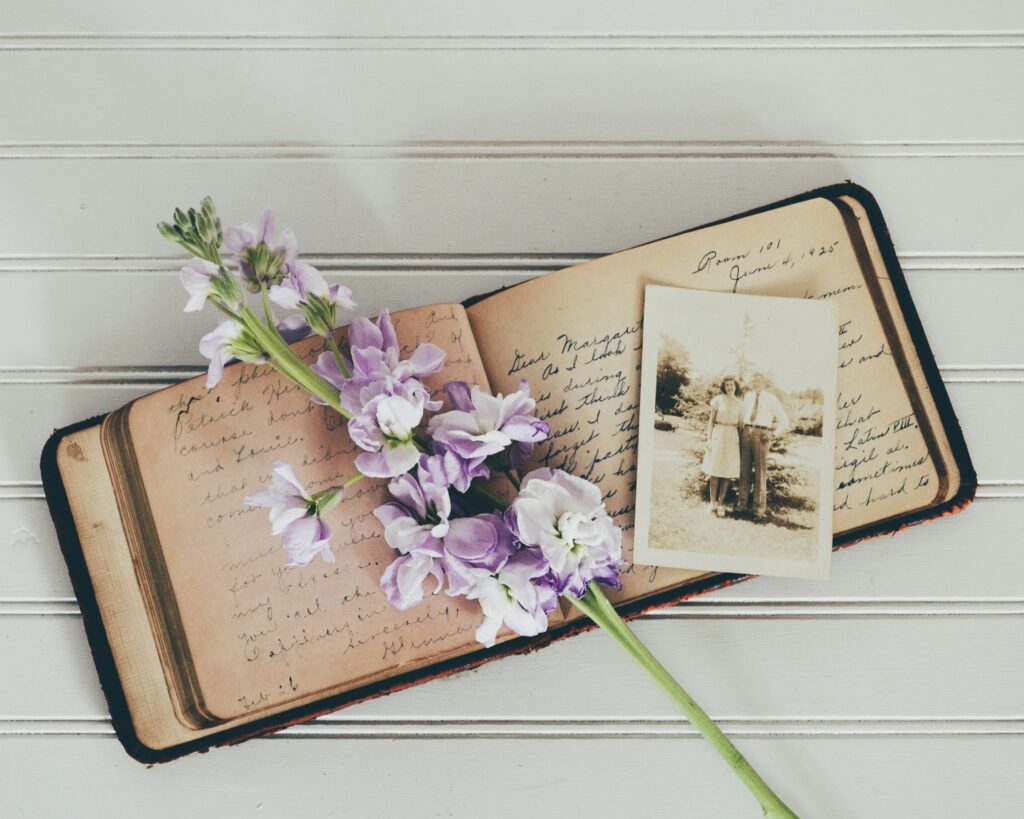
Eyes of the Beholden
Unspoken desires linger in the shadows of a teacher's life, revealed through art

LOST
Bessie's odyssey through stormy nights, lost love, and secret graveyards unfolds with haunting beauty in "Lost" by Sandra Dennis.

Water Rising
Amidst a flood, a woman grapples with the past, and confronts the consequences in this haunting narrative of resilience.

Book Review: White Nights by Urszula Honek
The debut short story from Polish writer Urszula Honek, White Nights, is akin to reading an account of a haunted place – one that is beautiful and devastating in equal
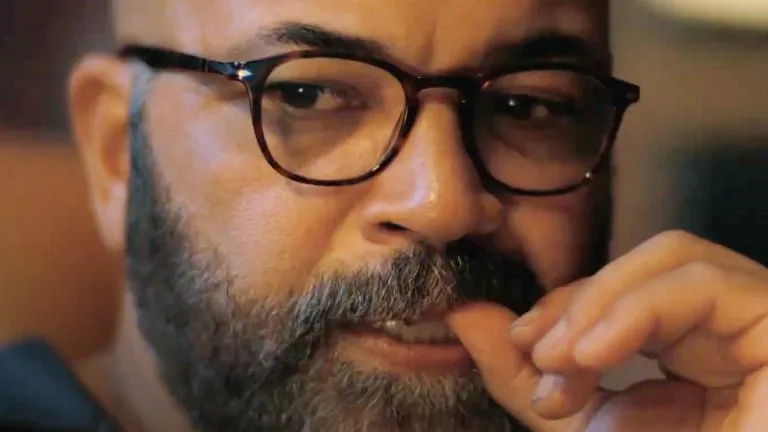
Beyond the Surface: The Multifaceted Lives of ‘American Fiction’
In essence, "American Fiction" and the experiences it draws from remind us that we are indeed more than the sum of our parts.
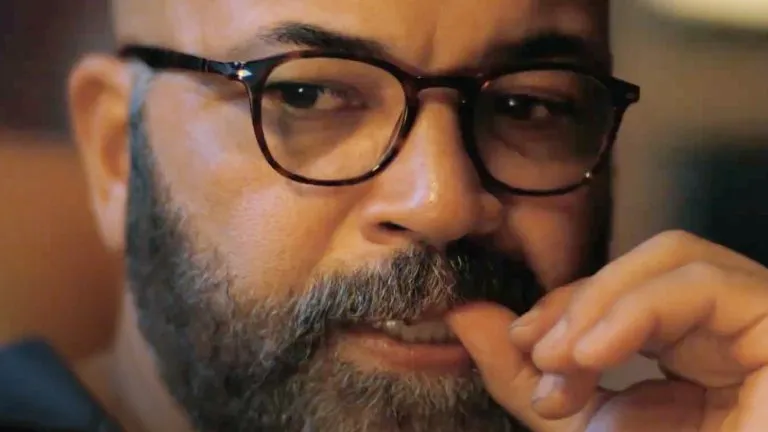
Beyond the Surface: The Multifaceted Lives of ‘American Fiction’
The narrative of “American Fiction” unfolds with a dual focus: it not only scrutinizes the unique pressures faced by Black creatives but also delves into the intricate and sometimes tense…

Uncle Bobby’s Funeral
Reluctant family faces the eccentricities of Uncle Bobby's funeral in swampy Chipley.




